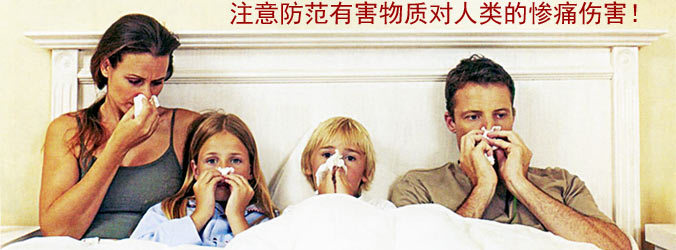
Harmful substance prevention
The company has passed the SGS ISO9001:2000 Quality Management System Certification and ISO14001:2004 Environmental Management System Certification.
There are five types of pollution in the indoor environment.
Benzene, ammonia, radon, and TVOC are relatively easy to dissipate under ventilation. As long as good indoor ventilation is ensured, they will generally disappear after 1-2 months.
A、 Benzene
It is a colorless gas with a special aromatic odor. Adhesives, paints, coatings, and bonding agents are the main sources of benzene in the air. After benzene and benzene homologues are inhaled by the human body, they can cause central nervous system anesthesia.
B、 Ammonia
It is a colorless gas with a strong pungent odor. It mainly comes from concrete antifreeze admixtures and flame retardants in fireproof boards. It has a strong irritating effect on the eyes, throat, and upper respiratory tract.
C、 Radon
It is a colorless, odorless, and undetectable inert gas. Cement, bricks, sand, marble, and ceramic tiles are the main sources of radon. Radon and its progeny enter the human body with the air, forming internal radiation, inducing lung cancer, leukemia, and respiratory diseases.
D、 TVOC
Total volatile organic compounds. Indoor building and decoration materials are the main sources of TVOC in the air. TVOC exhibits toxicity and irritation, can cause body immune disorders, and affect the function of the central nervous system.

E、 Free formaldehyde
Formaldehyde is a colorless, irritating, and water-soluble gas. It is the smallest aldehyde with a molecular weight. Its 35%-40% aqueous solution is commonly known as formalin. It is highly active and easily dissociates; it is highly toxic and carcinogenic; it has a long release period (10-15 years);
Formaldehyde Hazard Case 01
China's first case of formaldehyde exceeding the standard resulting in death was announced in Fujian Province
Source: Workers' Daily
In August 2006, Fuzhou City Court announced the first case in China of death caused by formaldehyde exceeding the standard due to new house decoration. Due to the serious excess of formaldehyde in Mr. Lin's newly renovated house, Mr. Lin's young daughter died of leukemia after moving in. The court's first-instance judgment ruled that the decoration and flooring companies should bear joint and several liability and jointly compensate the plaintiff more than 170,000 yuan.
In May and July 2004, Mr. Lin respectively contracted a decoration company and a flooring sales company to renovate his new house. In late August, Mr. Lin, his wife, and their 4-year-old daughter moved into the new house. On June 11, 2005, Mr. Lin's daughter suddenly developed persistent high fever and cough. The First Affiliated Hospital of Fujian Medical University diagnosed her with acute leukemia, and she died on August 27 of that year due to ineffective treatment.
After his daughter was diagnosed with acute leukemia, Mr. Lin commissioned the Fuzhou Environmental Monitoring Station to test the air in the master bedroom of the new house. The test report issued by the monitoring station on July 22, 2005, showed that the formaldehyde content in the air of the newly renovated house was still seriously exceeding the standard one year later, at 0.39 mg per cubic meter, exceeding the national standard by four times.
Formaldehyde Hazard Case 02
Amway office formaldehyde exceeding the standard caused a woman to need a kidney transplant; lawsuit awarded 2.33 million
Source: Indoor Environment Monitoring Committee
In January 2005, Ms. Liu joined the Hubei branch of Amway. From the beginning of her work, Ms. Liu's eyes began to water constantly, and then she felt unwell. In the following year, Ms. Liu was troubled by persistent high fever, nasal congestion, tearing, and sore throat.
In August 2006, doctors found that Ms. Liu's two kidneys were severely damaged, with only 20% function remaining, and signs of atrophy in both kidneys. In August 2007, Ms. Liu was diagnosed with uremia. In April 2008, Ms. Liu underwent a kidney transplant.
In the second half of 2007, Ms. Liu sued Amway. According to the test conducted by the Xiangfan City Environmental Monitoring Station in August 2006, one year and eight months after the renovation, the formaldehyde concentration in Ms. Liu's workplace was still more than one time the national standard. The Hubei Zhongzhen Forensic Appraisal Report concluded that the causal relationship between Ms. Liu's uremia and long-term exposure to formaldehyde in the office air exceeding the national standard could not be ruled out. On November 17, 2009, the Fanzheng District People's Court made a first-instance judgment: Amway should bear the main responsibility for Ms. Liu's personal injury and should bear 70% of Ms. Liu's various expenses, which totaled more than 3.34 million yuan, namely 2.338 million yuan.
